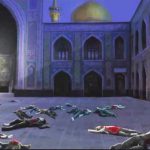
نیم نگاهی به جنایت رژیم پهلوی در تیرماه ۱۳۱۴ به زبان انگلیسی (جهت توزیع در شبکه های اجتماعی)
آن چه که در ادامه آمده جملاتی کوتاه به زبان انگلیسی در خصوص جنایت رژیم پهلوی در تیر ماه ۱۳۱۴ است که توزیع آن ها در بستر شبکه های اجتماعی و پیام رسان های مختلف می تواند گوشه ای از حقایق تاریخی ایران را به گوش مردم کشورهای دیگر برساند.
-تیر ماه ۱۳۱۴، قیام گسترده مردمی و مقاومت مدنی بر علیه دستور رضا شاه پهلوی مبنی بر ممنوعیت حجاب اسلامی، موجب قتل عام چند هزار زن ایرانی در شهرهای مختلف ایران شد.
-۲۱ تیر، سالروز قیام گوهرشاد و قتلعام مردمی است که در مقابل کشف حجاب رضاخانی ایستادگی کردند، این کشتار به قدری گسترده بود که تعداد شهدای این قیام تا چند هزار نفر هم گفته شده است. چند ماه بعد از این کشتار، رضاخان کشف حجاب را اجباری کرد.
-به همت فعالان تاریخ شفاهی انقلاب، بخشی از خاطرات مردمی مربوط به این واقعه جمعآوری شده است که در ادامه تعدادی از آنها را میخوانید.
نفرین میکند که فلج شوی، مامور دو روز بعد فلج میشود
حسین اسدی
سید عباس حسنی از نوادگان عبدالعظیم حسنی هستند. ایشان در روستای انجلاس همدان زندگی میکنند. یکی از ماموران عمامه ایشان را بر میدارند( هنگامی که ایشان از روستا به شهر میروند) مامورین، عمامه را زیر پای خود له میکنند و سید هم ایشان را نفرین میکند که فلج شود. این مامور هم دو روز بعد فلج میشود. بعداً از سید میخواهند که از این نفرین بگذرد و به این صورت میشود که ایشان میگذرد و مامور دستش دوباره سالم میشود.
مادربزرگم از شدت ضربه فوت کرد
خاطره از پریدخت فرشباف از مادربزرگ شهیدش، مکان واقعه کاشان
خانواده مادربزرگ من از بزرگان کاشان بوده اند، خانه آنها ۳۰ متری حمام بوده، روزی مادربزرگم که فکر نمیکرده کسی در این مسیر کوتاه، مزاحم او شود، به سمت حمام به راه میافتد. سربازی او را دنبال میکند، مادربزرگم از پلههای حمام پایین میافتد و بعد از چند روز به خاطر شدت ضربه، فوت میکند. مادر بزرگم در آن زمان دو فرزند ۶ و ۹ ساله داشتند.
پاسبان بازنشسته حسینعلی ذوالفقاری گلمکانی در مورد آمار مقتولان در شهر مشهد گفته است: «آن شب حدود دو سه هزار نفر را کشتند بردند بیرون دروازه پایین خیابان در قبرستان که الان درخت کاشتهاند خندق کندند هرکس که کشته میشد مثل جوال گندم همه را میریختند توی ماشین میبردند و میریختند توی آن خندق و خاک روی آنها میریختند البته از پاسبانها و نظامیها هم کشته شده بود که بروز داده نمیشد!»
In July, 1935, the vast people-driven revolt and civil resistance against Reza Shah Pahlavi’s order for the prohibition of Islamic Hijab causes the murdering of several thousands of Iranian women in various cities.
July 21st marks the anniversary of Gawharshad Revolt and the massacre of the people who resisted Reza Khan’s unveiling (Kashf-e-Hijab) Campaign. The massacre was so vast that the number of the revolt’s martyrs is said to have been over several thousands. A few months after the slaughter, Reza Khan made unveiling compulsory.
Some parts of people’s memories regarding the incident have been compiled by the efforts of the oral revolution history activists and offered in the forthcoming sections.
He cursed him to become paralyzed and he became so two days later.
Hussein Asadi
Sayyed Abbas Hassani is a descendant of his highness Abdulazim Hassani. He lives in Enjelas village in Hamadan. (When he goes from village to the city) One of the agents removes his turban and the other agents trample the turban beneath their boots and Sayyed curses him to become maimed. The agent became paralyzed two days later. Then, Sayyed was asked to dispel the curse and he forgives the man and the agent becomes healthy again.
My grandmother died of the intensity of the strikes:
A memory from Paridokht Farshbaf about her martyred grandmother, the incident place: Kashan
My grandmother’s family was very famous and well-known in Kashan. Their house was situated within a 30-meter distance from the public bath. One day, she, who did not think any persons might disturb her in such a short path, starts walking towards the bath. A soldier chases her and my grandmother stumbles down the bath stairs and dies several days later for the intensity of the strikes. At that time, my grandmother had two 6 and 9-year-old children.
A retired police, named Hussein Ali Zolfaghary Golmakany, speaks about the death tolls in Mashhad: “that night, they killed about two or three thousand people and took them outside the city gate down the street in a graveyard wherein there are now trees planted. They dug a trench and they threw anyone who was killed into a truck like a sack and buried in the trench and covered with soil. Of course, some police officers and military men were killed but it was not announced!”